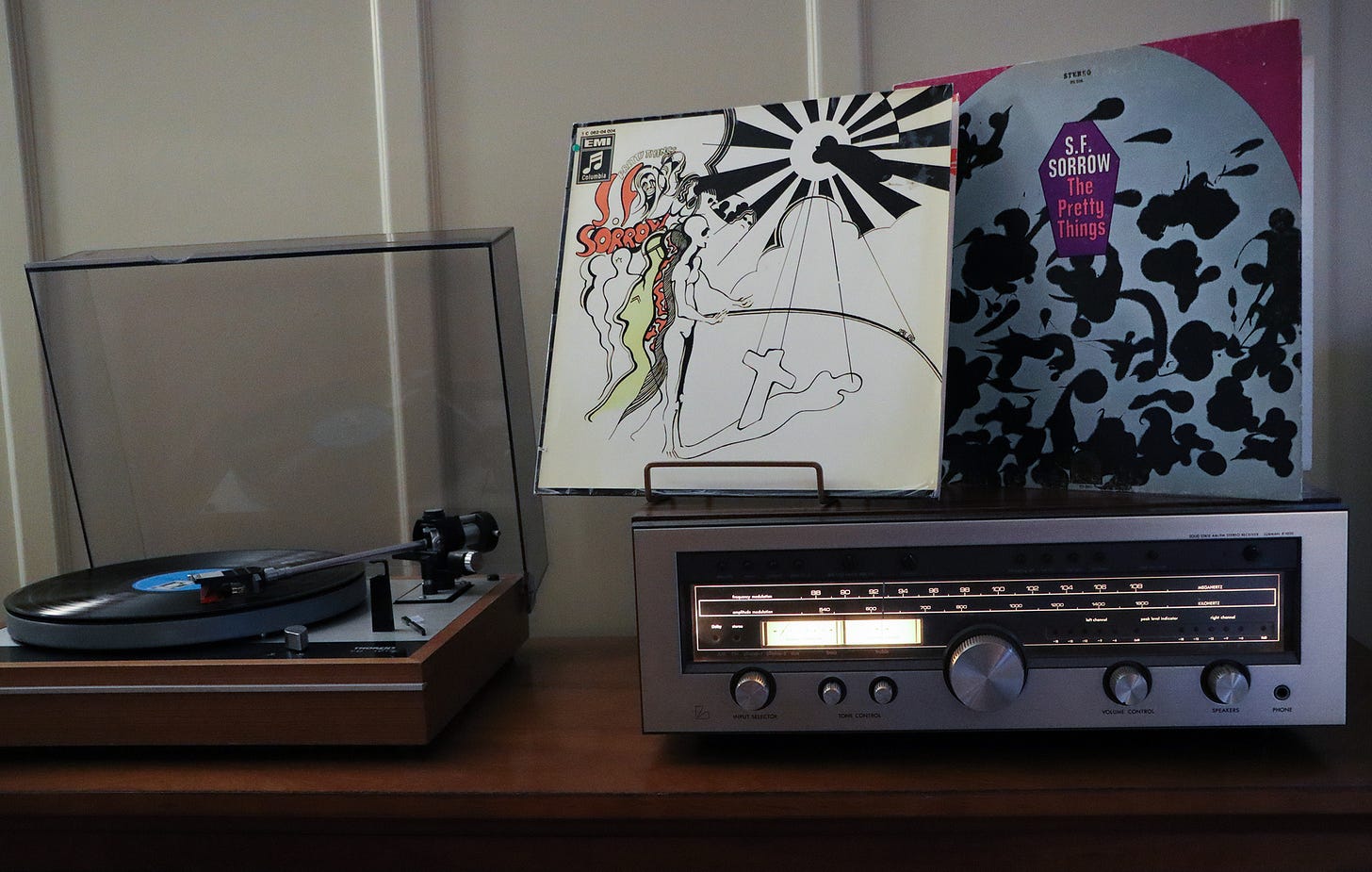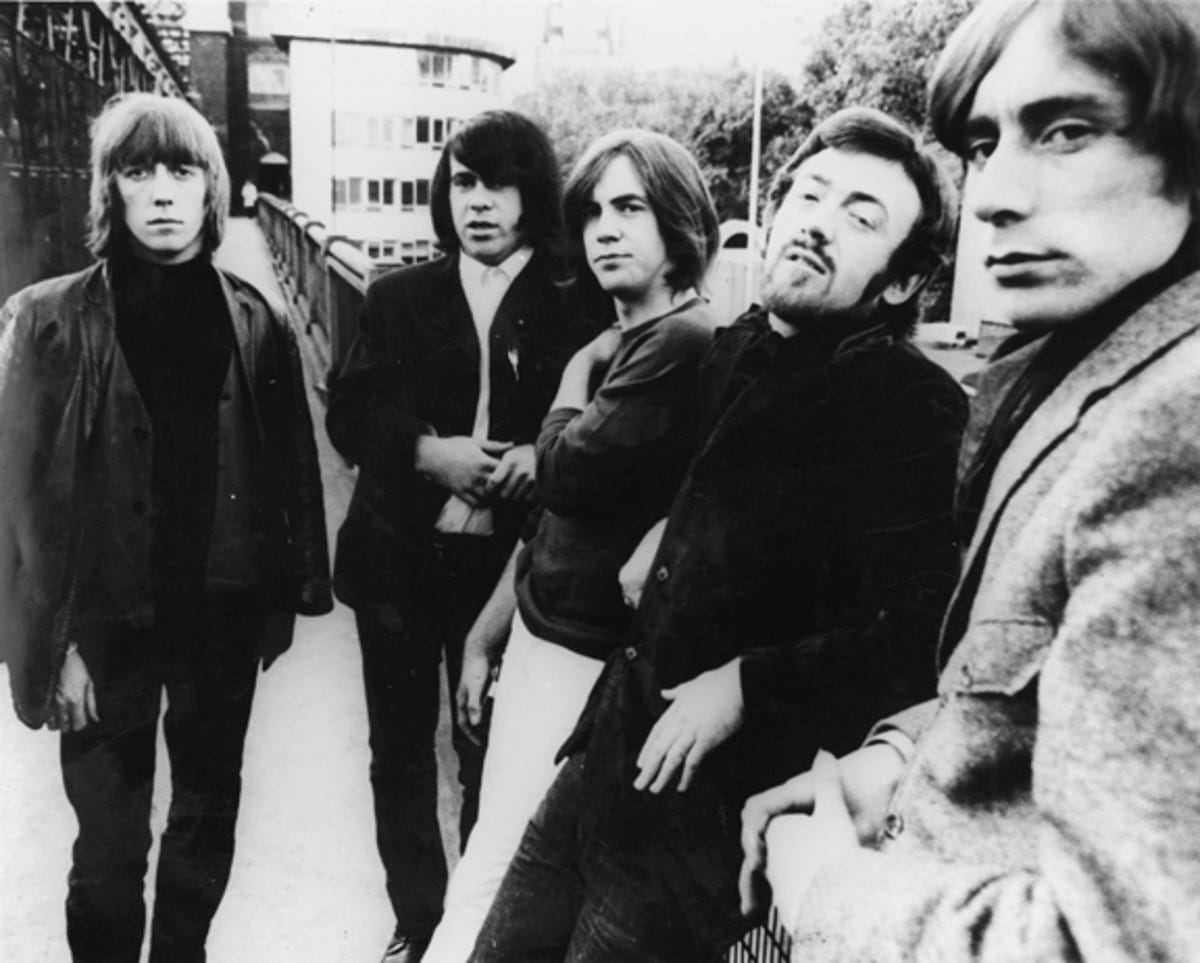Bouquets From A Cloudy Sky
“The Pretty Things invented everything, but are credited with nothing.”
I am often asked, “What is your favorite album or band?” I find this a difficult question to answer because there are so many albums across various genres that I own and love dearly. Thousands of rock, folk, funk, soul, jazz, gospel, and African records line my shelves. When thinking deeper about the question, I am reminded of the fantastic BBC Radio 4 series, “Desert Island Discs.” The program asks its celebrity guests, referred to as “castaways,” what items they would choose to take with them on a desert island. They are allowed up to eight records, a book, and a luxury item. As the guests share reasons behind their choices, excerpts from the records are played for the program’s listeners. Ultimately, the castaway has to choose the most precious and meaningful item on their list. Its simple format is brilliantly conceived and makes for a fascinating radio show that started in 1942 and continues today.
Over the years, I have had many “Desert Island Discs” conversations with friends. It’s always a fun pub discussion that garners laughter, banter, debate, and often deeper dialogue. Inevitably, it is also a frustrating conversation because any art lover knows that committing to a list eliminates many great works, and one’s choice today may change tomorrow. There are many albums, songs, and bands that I greatly enjoy simply for the love of music. Others are so influential and impactful to my life that they speak to me on a deeper and more emotional level. My first two posts on this Substack highlight two of those albums. Not too long after I discovered Country Joe & The Fish's ‘Electric Music For The Mind & Body,’ which I discussed in “A Wave of Electrical Sound,” I heard another album that, to this day, I hold as the gold standard for rock music.
I should preface by saying that even in a loud & busy environment, when music is playing, my ears listen, and my mind absorbs. If the music isn’t of importance or doesn’t stand out, it retreats to the background. When it’s something I like or piques my interest, my brain finds space to listen, and I can still multi-task despite how overwhelming or busy it may be.
When I was seventeen, I was with a friend, and we went to somebody’s house in Cleveland who I didn’t know. We were sitting in the small living room with a guy in his twenties, and I noticed several hundred decorated Grateful Dead tapes lining the wall and a small hi-fi playing a record. As we talked, my attention went to the music emanating from the stereo. I became more interested in the record's sounds than our small talk in the dark, cluttered living room. “What are you playing?” I eventually asked. He grabbed the album cover and handed it to me. It was a double LP with the other record still in its gatefold sleeve. The cover was light cream and had a surreal collage with a butterfly, nude women, fruit, a sesame seed hamburger bun, and a coastline looking distinctly Californian. I opened its gatefold, and inside was a sepia photo of a long-haired, grumpy-looking English band with liner notes by somebody named Ben Edmonds. On the back was a vintage photo of a 1920s-era woman looking vaguely like Clara Bow, holding flowers. The album was called ‘Real Pretty’ and was a two-record set by a British band called The Pretty Things. I had never heard of them, but apparently, this 1976 release compiled two of their albums, ‘S.F. Sorrow’ (1968) and ‘Parachute’ (1970).
Unexpectedly, he kindly said, “Cool record, do you want to borrow it?” I was taken aback as we didn’t know each other. “Sure”, I said. He took the record off the stereo, put it into its sleeve, and said, “Just bring it back to me next week.” When I got home, I put the album on and was mesmerized and completely blown away by the music stretching across its four sides. “Who is this band?” I thought. One must remember that before the Internet, it was much harder to find this information. Nonetheless, I grabbed a blank 90-minute Maxell XLII and recorded the double LP with ‘S.F. Sorrow’ on the tape’s A-side and ‘Parachute’ on its flip. After returning the record, I prioritized finding a copy for myself and learning more about these mysterious Englishmen.
I eventually found the information I was searching for via record collector magazines, ‘zines, and books. Formed at Sidcup Art College in Kent, England, an early incarnation of the band included guitarist Dick Taylor as well as Mick Jagger, Keith Richards, Ian Stewart, Charlie Watts, and Brian Jones. Several band names later, and they were eventually calling themselves ‘The Rollin’ Stones’. Dick Taylor, who at the time was playing bass, increasingly wanted to return to guitar and form his own band. In 1962, Taylor left and formed The Pretty Things with another fellow art school chum, Phil May. Taking their name from a Bo Diddley song, they were an even rougher, longer-haired, and more chaotic version of the Stones playing thrashed-out R&B. They also harnessed a legendary sense of outrage and danger that caused a riot in Holland, New Zealand’s Parliament debated entry permits to bands as well as placed a rumored lifetime ban on the Pretty Things, their hit single banned from US radio, and they caused moral panic in stuffy middle-class England. In 1973, at the peak of his success, David Bowie covered a Pretty Things song for his ‘Pin Ups’ album, and they would later have a significant influence on Punk. The Sex Pistols’ first public gig was supporting The Pretty Things at the Roxy in London. In interviews, Joey Ramone acknowledged that “The Pretty Things had the biggest influence on The Ramones,” and “they invented garage bands”. However, it was English musician Arthur Brown who summed up their influence best when saying, “The Pretty Things invented everything, but are credited with nothing.” Their reputation not only as rock & roll bad boys but inspiring artists had hit mythical proportions, and I was only just discovering them.
While both albums in the compilation are stunning in their own right, it’s their fourth album, ‘S.F. Sorrow,’ which made an immediate impact on me. Recorded between 1967 and the autumn of 1968, ‘Sorrow’ is a 40-minute concept album now regarded as the first-ever rock opera. Taking his inspiration from both opera and classical music, Phil May challenged the idea of what a rock album was and what it could be by illustrating a story with music. Stretching across two sides, it forces the listener to actively engage with the songs and creates a natural “intermission” when flipping the record over. While The Who’s ‘Tommy’ is often miscredited as the first rock opera, Pete Townshend would later admit to being inspired by ‘S.F. Sorrow.’
Throughout its thirteen songs, ‘S.F. Sorrow’ richly tells the story of the life and lonely death of “Sebastian F. Sorrow.” Musically, it’s dark, layered and textured. In between, the late ‘60s British pop harmonies weave a floating psychedelic tapestry of atmospheric mellotron passages, fuzzy backward guitar loops, sitars, phase, flange, ring modulators & other shifting electronic effects. There are even crunching, proto-metal speed guitar riffs in the intensely pulsating “Balloon Burning” and raucous “Old Man Going.” Lyrically, the songs are introspectively melancholic and moody. Unlike many English bands of their time, Phil May not only embraces his English accent, he unapologetically allows it to take front and center. From the vibrant opening guitar chords of “S.F. Sorrow is Born” to May’s heart-aching final words in “Loneliest Person,” it’s a highly creative, radical, and inspirational album of remarkable vision, experimentation, power, & beauty. The band was taking creative risks, their ideas were flowing, and ultimately, a masterpiece made by artists at the peak of their creativity. Its uniquely post-war British sounds could also only have emerged from the swinging ’60s youth generation rising out of the ghosts of war and challenging the system of a bygone era and empire.
‘S.F Sorrow’ is a fantastic artistic statement by a band proving they could make high art using popular music as their chosen medium. The Pretty Things resonated with me more than any band of my generation and propelled me to dive deeper into my love of records and music. Even more remarkable is when I heard ‘S.F. Sorrow,’ the record was already 18 years old, yet it sounded significantly more forward-thinking than most albums of my day. The record also quickly became the soundtrack to my late teens. I can also state, with unequivocal confidence, that the album would be one of my Desert Island Discs, and I’d be a happier castaway with it in my possession.
The Pretty Things - ‘S.F. Sorrow’, 1968 (Spotify Link)








Very nice. I discovered SF Sorrow (and Parachute) via Real Pretty as well, back in my college days. After a very rough 2022, I celebrated surviving it by treating myself to the SF Sorrow box set that came out a few years back, complete with reproductions of their really psychedelic 45s from the period. It has never left my living room since.
More excellence! You really bring this to life. The funny thing about the Desert Island Discs concept is that I always think my most beloved recordings might not make the listing because they are so vividly embedded in my head already. However, if listening to them still has the power to transport me, then what better way to travel from the island?